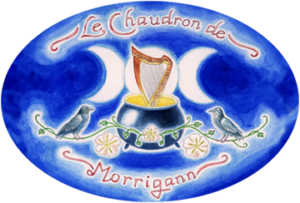Contact :
Brighid’s Mantle (Imbolc, Candlemas)
Brighid and her mantle
In legends and folklore…
Along with Brighid’s Cross, Brighid’s Mantle is one of the main symbols used at Imbolc and just like the Cross, it is part of the rituals and celebrations. While the Cross refers to the Irish goddess, Brighid’s Mantle alludes to Saint Brighid (of Kildare), who is no other than a Christian form of the ancient goddess.
It is said that Brighid went to the King of Leinster to ask him for some land where she could build an abbey. As one can imagine, as the King did not want to see such a thing done, he replied that he would give her the surface that could be covered by the mantle she was wearing. Of course, when Brighid spread her cloak on the ground, it expanded and covered all the surface that was necessary for the construction of the foundations of the building.
According to other sources, Brighid was with the Virgin Mary in Bethlehem when she gave birth to Christ. She acted as a midwife and wrapped the newborn child in her mantle, thus protecting him and keeping him in good health.
In other tales, she hangs her mantle on a sunbeam to get it to dry after being caught in a storm.
… in the traditions of Imbolc…
All these legends contribute in making Brighid’s Mantle a sacred item. Various beliefs are still attached to this piece of cloth today. The most common idea is that Saint Brighid gives some of her healing powers to the pieces of cloth that are hung at Imbolc. According to the custom, a cloth has to be hung inside or outside the house at Imbolc so Brighid can bless it when she comes. This cloth is then called Brighid’s Mantle and is hung again each year at Imbolc so Brighid can bless it every time. That is how it keeps its healing powers, which keep on growing year after year.
… in this spread
The spread presented here takes the shape of Brighid’s cloak and refers to the protection and healing energies she blesses the querent with at Imbolc. Of course, the different parts of the spread are inspired by the abilities and attributions attached to this very peculiar figure who, while being Christian, represents a link between the old ways and the new ways.
Object
This spread shows what Saint Brighid wraps the querent in at Imbolc in order to give them the protection they need and to help them heal from what they need to leave behind.
How to proceed
After shuffling and cutting the deck, draw eighteen cards and lay them out as follows:

Interpretation
The cards are read in the same order they were drawn. It can be noticed that the first and last cards of the bottom line are tilted in order to give more fluidity to the mantle shape. Of course, this special position gives these cards special meanings, which are revealed during the reading.
Card 1 shows the querent’s desires and wishes. It reveals what they want to accomplish the most.
Cards 2, 3, 4 and 5 refer to the querent’s present situation. They show what is happening around them in general and express their main concerns.
Card 6 puts into light the querent’s fears and what they worry about, especially regarding the present situation.
Just above the first line, cards 7, 8, 9, 10 and 11 show what the querent need to heal from, what they need to let go before they can move forward peacefully. These cards represent what Saint Brighid will help them to overcome.
Cards 12, 13, 14 and 15 describe what kind of protection Brighid blesses the querent with regarding their general situation and their healing process.
Cards 16, 17 and 18 reveal the strengths and qualities Brighid gifted the querent when she leant over their cradle as they were a newborn child. These cards insist on what will help them the most in dealing with their present situation.
Further remarks
This spread is rather easy to work with. The different parts contain a small number of cards to be read together each time, which makes it easier for those who are not used to reading spreads with so many cards.
Each part can be read in two different ways: either by establishing connections between the cards as if they were telling a story (thus showing a situation as it unfolds, or successive events), or one card at a time (each card thus depicting one or several aspects of one or several situations). The reader chooses the best way to read the cards according to what they think is relevent depending on the cards that appear in the spread.
Which decks for this spread?
Tarot and oracle decks can be used for this spread (but not Lenormand decks, which use their own system). Of course, Neo-Pagan themed decks will be preferred, as well as decks that display Imbolc related symbols and customs. Decks with an Irish setting are also particularly appropriate.
(© Morrigann Moonshadow, February 2nd, 2016; trans. February 10th, 2016. Further reproduction prohibited.)




